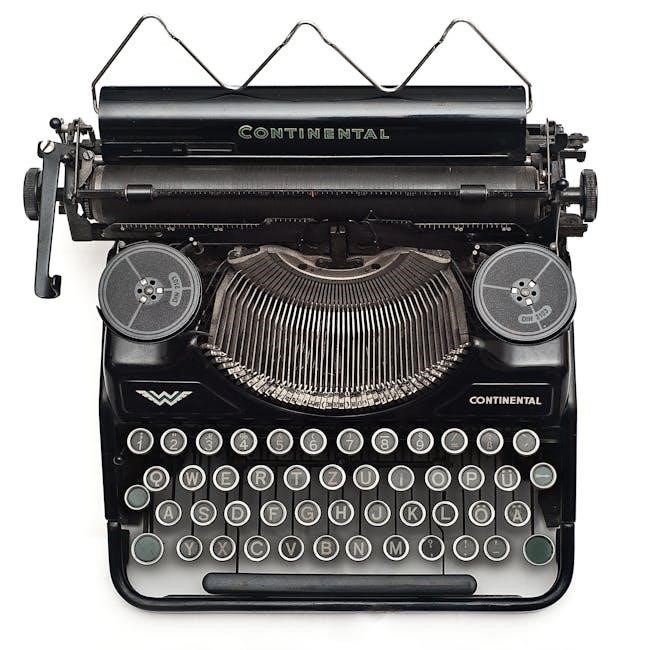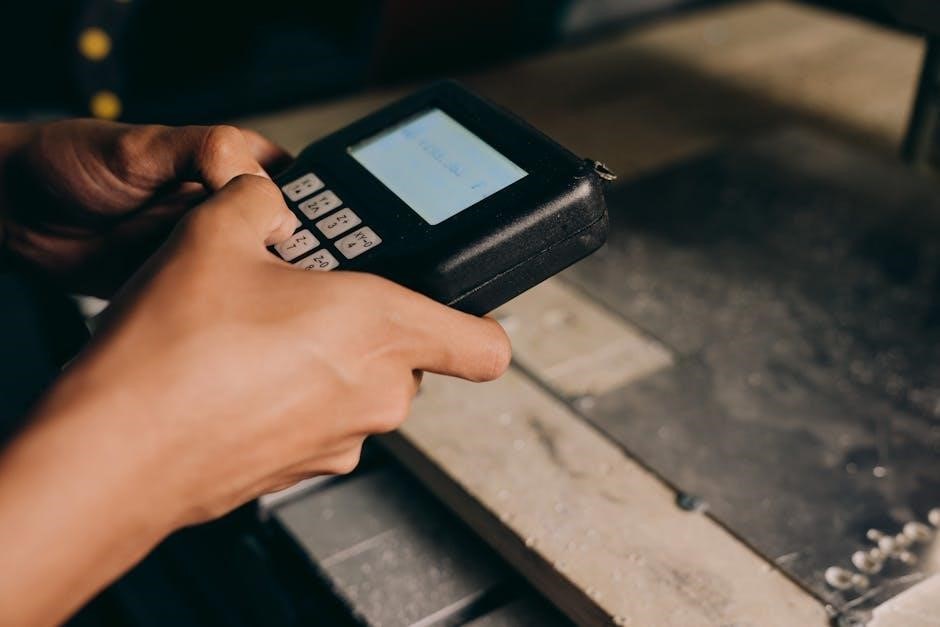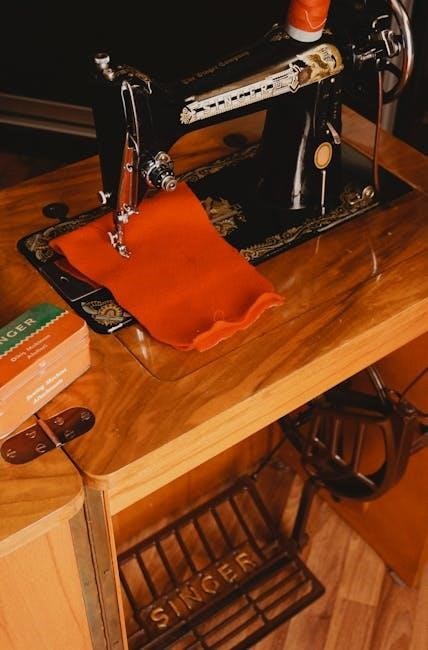Singer 4423 User Manual: A Comprehensive Guide
Unlock the full potential of your Singer 4423 with this comprehensive guide. This manual offers clear, concise instructions, from initial setup to advanced techniques. Discover all the features and capabilities of this heavy-duty sewing machine.
Overview of the Singer 4423 Sewing Machine
The Singer 4423 Heavy Duty sewing machine is designed for both amateur and professional sewists alike, offering a robust set of features to enhance both durability and performance. This versatile machine is built to handle a wide range of fabrics, from lightweight sheers to heavy denim and canvas, making it a reliable choice for various sewing projects.
Powered by a strong motor, the Singer 4423 provides an impressive sewing speed of 1,100 stitches per minute, which allows users to complete their projects quickly and efficiently. The adjustable presser foot pressure allows you to sew a wide variety of fabrics. Its heavy-duty metal frame ensures stability and long-lasting use, even when working on tough materials.
The Singer 4423 features a variety of built-in stitches, offering creative options for different sewing needs. With its user-friendly design and comprehensive instruction manual, the Singer 4423 is an excellent choice for anyone looking for a dependable and high-performing sewing machine. Whether you are a beginner or an experienced sewist, this machine provides the power and versatility needed to bring your sewing projects to life.

Accessing the Instruction Manual
Gaining access to the Singer 4423 instruction manual is crucial for unlocking the full potential of your sewing machine. Whether you’ve misplaced the physical copy or prefer a digital version, several avenues are available to ensure you have the information you need at your fingertips.
If you have lost the physical copy of your Singer 4423 instruction manual, don’t worry, many resources offer replacements. Soft-cover printed photocopies of the manual are often available for purchase. For those who prefer digital access, the manual can be downloaded for free as a PDF file from various online sources, including the Singer website and other sewing machine resource sites.
The digital manual is easily searchable, allowing you to quickly find specific instructions or troubleshooting tips. Websites dedicated to sewing machine manuals provide a convenient way to view and download the Singer 4423 manual. This ensures you can always reference the manual on your computer, tablet, or smartphone, making it accessible whenever and wherever you need it.
By utilizing these resources, you can ensure you always have the necessary guidance to operate and maintain your Singer 4423 sewing machine effectively.
Important Safety Instructions

Before operating the Singer 4423 sewing machine, it is crucial to familiarize yourself with the important safety instructions outlined in the user manual. These instructions are designed to prevent injury and ensure the safe operation of the machine. Always read all instructions carefully before using the sewing machine.
When using an electrical appliance like the Singer 4423, basic safety precautions should always be followed. Never operate the machine if it has a damaged cord or plug, or if it is not working properly. In such cases, it should be returned to Singer or a qualified service agent for repair or replacement.
To reduce the risk of electric shock, always unplug the sewing machine from the electrical outlet when making adjustments in the needle area, such as threading the needle or changing the needle. Also, switch off the machine before performing any maintenance or cleaning.
Use only attachments recommended by the manufacturer. Never operate the machine where oxygen is being administered or near flammable materials. Always turn off the machine and remove the plug from the outlet when not in use or before changing the light bulb.
By adhering to these safety instructions, you can ensure a safe and enjoyable sewing experience with your Singer 4423.
Setting Up the Machine
Proper setup of your Singer 4423 sewing machine is essential for optimal performance and longevity. Begin by placing the machine on a stable, flat surface. Ensure adequate lighting in your workspace to prevent eye strain. Connect the foot pedal and power cord to the machine and plug it into a functioning electrical outlet.
Before turning on the machine, familiarize yourself with the various components, including the bobbin winder, thread guides, tension dial, stitch selector, and presser foot lever. Consult the user manual for detailed diagrams and explanations of each part.
Next, install the appropriate needle for your chosen fabric. Loosen the needle clamp screw, insert the needle with the flat side facing the back, and tighten the screw securely; Ensure the needle is fully inserted to prevent skipped stitches or damage to the machine.
Attach the desired presser foot for your sewing project. Align the presser foot with the presser foot holder and lower the presser foot lever to secure it in place. Refer to the manual for instructions on changing presser feet.
Finally, check that all cords and attachments are properly connected before powering on the machine. With the machine set up correctly, you’re ready to begin threading and winding the bobbin.
Threading the Needle and Winding the Bobbin
Threading the needle and winding the bobbin are crucial steps in preparing your Singer 4423 for sewing. Start by placing a spool of thread on the spool pin, securing it with the spool cap. Follow the thread guide, leading the thread through the tension disc and down to the bobbin winder.
To wind the bobbin, place an empty bobbin on the bobbin winder spindle and push it to the right. Engage the bobbin winder by pressing the foot pedal. The machine will automatically stop when the bobbin is full. Trim the thread and remove the bobbin from the spindle.
Next, insert the bobbin into the bobbin case, ensuring the thread unwinds in the correct direction (refer to the diagram in the manual). Thread the machine needle by following the upper thread path, guiding the thread through each thread guide and the tension regulator.
Finally, thread the needle from front to back, pulling a few inches of thread through the eye. Bring up the bobbin thread by holding the needle thread loosely and turning the handwheel towards you. Both threads are now ready for sewing.
Consult the user manual for detailed illustrations and troubleshooting tips if you encounter any difficulties during the threading or bobbin winding process.
Operating the Machine: Basic Sewing Techniques

Once your Singer 4423 is threaded and ready, you can begin exploring basic sewing techniques. Start by placing your fabric under the presser foot, ensuring it’s aligned with the desired seam allowance. Lower the presser foot lever to secure the fabric.
Gently depress the foot pedal to begin sewing. Maintain a consistent speed and guide the fabric smoothly, letting the machine feed it through. For straight seams, follow a seam guide on the needle plate. To pivot, stop with the needle down, lift the presser foot, rotate the fabric, and lower the presser foot again.
When you reach the end of your seam, stop with the needle down, lift the presser foot, and pull the fabric away from the machine. Use the thread cutter to trim the threads. To secure your stitches, use the reverse stitch function at the beginning and end of each seam.
Experiment with different stitch lengths and widths to achieve various effects. Practice sewing straight lines, curves, and corners on scrap fabric before working on your actual project. The manual provides guidance on selecting appropriate stitch settings for different fabric types.
Remember to always keep your fingers away from the needle while the machine is operating and consult the troubleshooting section of the manual if you encounter any issues.
Adjusting Settings and Features
The Singer 4423 offers a range of adjustable settings and features to customize your sewing experience. One key adjustment is stitch length, controlled by a dial typically located on the front or side of the machine. Increase the stitch length for basting or sewing thicker fabrics, and decrease it for finer fabrics or detailed work.
Stitch width can also be adjusted, particularly for zigzag stitches. A wider stitch is suitable for creating satin stitches or appliques, while a narrower stitch works well for edge finishing. The machine also features adjustable presser foot pressure. Reduce pressure for delicate fabrics to prevent marking or puckering, and increase it for heavier fabrics to ensure proper feeding.
The needle position can be adjusted on some models, allowing you to move the needle to the left, center, or right. This is useful for tasks like sewing zippers or creating decorative topstitching. Familiarize yourself with the location and function of each adjustment dial or lever by consulting your user manual.
Experiment with different settings on scrap fabric to understand their effects. Pay attention to the recommendations in the manual for specific fabric types and sewing techniques. Proper adjustment of these settings will enhance the quality and appearance of your finished projects.
Troubleshooting Common Issues
Even with a robust machine like the Singer 4423, occasional issues can arise. One common problem is thread breakage. This can often be resolved by re-threading the machine, ensuring the thread is properly seated in all guides and tension discs. Also, make sure you are using the correct type and size of needle for your fabric.

Another frequent issue is skipped stitches. This can occur if the needle is bent or damaged, or if the timing of the machine is off. Try replacing the needle and double-checking that it is securely inserted. If skipped stitches persist, the machine may require professional servicing.
Fabric bunching or jamming can also be problematic. This is often caused by incorrect thread tension, improper fabric feeding, or using the wrong presser foot. Adjust the tension settings, ensure the feed dogs are properly engaged, and select the appropriate presser foot for your project.
If the machine is making unusual noises or running sluggishly, it may need lubrication or cleaning. Refer to your user manual for instructions on how to properly maintain your Singer 4423. Addressing these common issues promptly will help keep your machine running smoothly and prevent more serious problems from developing. Always consult the manual first!
Maintenance and Care
Proper maintenance is crucial for extending the life and ensuring the optimal performance of your Singer 4423 sewing machine. Regular cleaning is essential; use a soft brush to remove lint and dust from the bobbin area, feed dogs, and other accessible parts. This prevents buildup that can impede smooth operation.
Lubrication is also vital. Apply a few drops of sewing machine oil to the designated points as indicated in your user manual. Oiling moving parts reduces friction and wear, contributing to quieter and more efficient sewing. Be sure to use only sewing machine oil, as other types of oil can damage the machine.
When not in use, cover your Singer 4423 to protect it from dust and sunlight. Store it in a cool, dry place to prevent rust and corrosion. Regularly inspect the needle for damage and replace it as needed. A dull or bent needle can cause skipped stitches and fabric damage.
Periodically check and tighten any loose screws or parts. If you encounter any major issues or are unsure about performing maintenance tasks, consult a qualified sewing machine technician. Following these simple maintenance and care tips will help keep your Singer 4423 in excellent condition for years to come. Keeping your machine covered also help keep dust out.

